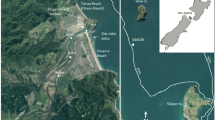Abstract
In order to manage estuaries effectively, it is important to be able to predict how they are likely to change in the future, both to natural and anthropogenic forcing. This paper looks at historical morphological development of the Thames Estuary, taking into account the effect of human intervention, and uses the ASMITA morphological model to predict the long-term evolution of the estuary into the future, assuming either historic rates of sea-level rise or accelerated sea-level rise. The historical sediment budget for the Thames Estuary was examined and source and sink terms, including fluvial sediment supply and historical dredging rates, were included in the ASMITA model. ASMITA predictions showed good overall agreement with the historical data, highlighting the benefits of detailed historical review and the inclusion of anthropogenic effects in the model. Future ASMITA predictions for the period 2000 to 2100 suggest that, under both historical and accelerated sea-level rise scenarios, the estuary will experience accretion, but, for the accelerated sea-level rise scenario, accretion will be at a slower rate than sea level rise. With accelerated sea-level rise, intertidal profiles were predicted to be up to 0.5 m lower with respect to high water.







Similar content being viewed by others
References
Davis FWD (1949) River Thames Siltation Investigation, June 1949.
DEFRA (2006) Flood and coastal defence appraisal guidance. Technical report. Department for Environment, Food and Rural Affairs, London
Dyer KR (2002) FutureCoast estuary assessment. FutureCoast, Halcrow, Swindon
HR Wallingford (1988) Maidenhead, Windsor and Eton Flood Study: morphological model studies, HR Wallingford Report EX 1695
HR Wallingford (2006a) Thames Estuary 2100: Morphological changes in the Thames Estuary. Technical note EP6.8, The development of a historical sediment budget
HR Wallingford (2006b) Thames Estuary 2100: Morphological changes in the Thames Estuary. Technical note EP 6.4, Historical Trend Analysis
Inglis CC, Allen FH (1957) The Regimen of the Thames estuary as affected by currents, salinities and river flow. Proc Inst Civil Eng 7:827–878
Kragtwijk NG, Zitman TJ, Stive MJF, Wang ZB (2004) Morphological response of tidal basins to human interventions. Coast Eng 51:207–221
Nicholls RJ, Dredge A, Wilson T (2000) Shoreline change and fine-grained sediment input: Isle of Sheppey Coast, Thames Estuary, UK. In: Pye K, Allen JRL (eds) Coastal and estuarine environments: sedimentology, geomorphology and geoarchaeology. Special Publications, 175. Geological Society of London, London, pp 305–315
Stive MJF, Wang ZB, Capobianco M, Ruol P, Buijsman MC (1998) Morphodynamics of a tidal lagoon and the adjacent coast. In: Dronkers S (ed) Physics of estuaries and coastal seas. Balkema, Rotterdam, pp 397–407
van der Wal D, Pye K (2004) Patterns, rates and possible causes of saltmarsh erosion in the Greater Thames area (UK). Geomorpholgy 61:373–391
van Goor MA, Zitman TJ, Wang ZB, Stive MJF (2003) Impact of sea-level rise on the morphological equilibrium state of tidal inlets. Mar Geol 202:211–227
Walkden M, Rossington K (2009) Characterisation and prediction of large scale, long-term change of coastal geomorphological behaviours: Proof of Concept Modelling. Project Record — SC060074/PR, Environment Agency, Bristol.
Wang ZB, de Vriend HJ, Stive MJF, Townend IH (2007) On parameter setting of semi-empirical long-term morphological models for estuaries and tidal lagoons. Proceedings of 5th IAHR Symposium on River, Coastal and Estuarine Morphodynamics, Enschede, the Netherlands 103–112
Water Pollution Research Laboratory (1964) Effects of polluting discharges on the Thames Estuary, The Reports of the Thames Survey Committee and of the Water Pollution Research Laboratory, Water Pollution Research Technical Paper Number 11, Water Pollution Research Laboratory, HMSO
Acknowledgements
The work presented here was largely funded by the DEFRA FD2107 Project. We are also very grateful to the Port of London Authority for their cooperation and assistance.
Author information
Authors and Affiliations
Corresponding author
Additional information
Responsible Editor: Alejandro Jose Souza
Rights and permissions
About this article
Cite this article
Rossington, K., Spearman, J. Past and future evolution in the Thames Estuary. Ocean Dynamics 59, 709–718 (2009). https://doi.org/10.1007/s10236-009-0207-4
Received:
Accepted:
Published:
Issue Date:
DOI: https://doi.org/10.1007/s10236-009-0207-4




